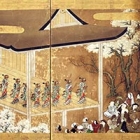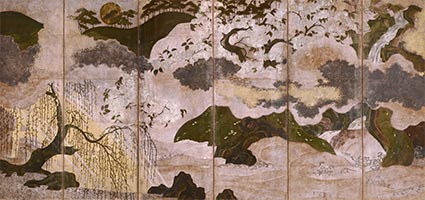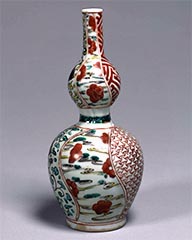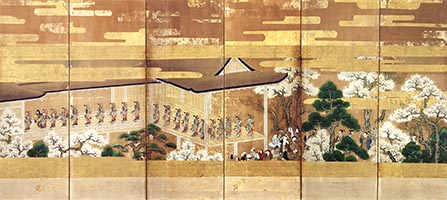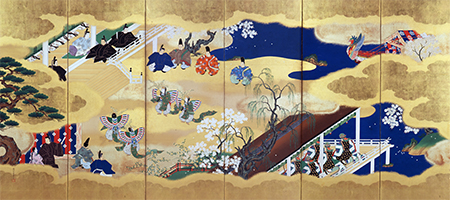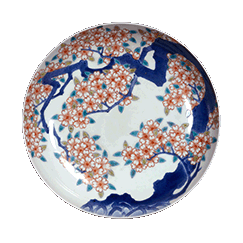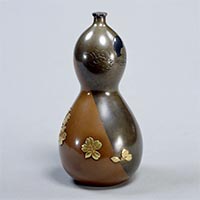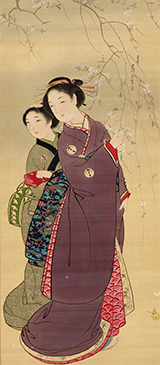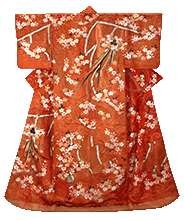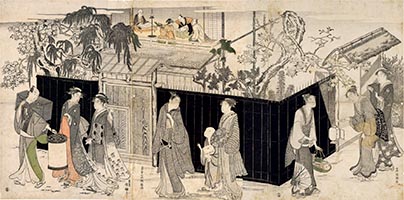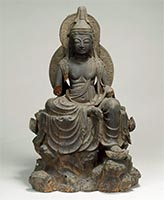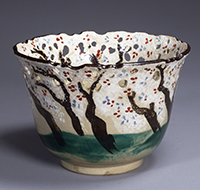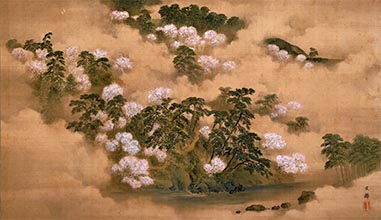Courtly Art: Heian - Muromachi period
Landscape with the Sun and Moon (right screen)
Muromachi period, 16th century (Important Cultural Property)
Room 3, March 1 - April 10, 2016
The sun and moon are depicted with gold and silver plating, respectively. Presumably these screens were combined from two different works as suggested by the differences in technique and the disjointedness of the compositions.
The Art of Tea Ceremony
Sake Bottle, Cherry blossom and stream design in overglaze enamel
Imari ware, Edo period, 17th century (Gift of Mr. Hirota Matsushige)
Room 4, March 15 - June 5, 2016
Folding Screens and Sliding Door Paintings: Azuchi-Momoyama - Edo period
Kabuki Theater and Other Amusements (right screen)
Artist unknown, Edo period, 17th century (Important Cultural Property, Lent by the Agency for Cultural Affairs)
Room 7, March 8 - April 17, 2016
Scenes from The Tale of Genji, Chapters of Eawase (Picture-matching contest) and Kocho (Butterflies) (left screen)
By Kano Seisen'in (Osanobu), Edo period, 19th century
Room 7, March 8 - April 17, 2016
The left screen features the Kocho chapter of The Tale of Genji, Umetsubo (Crown Princess Akikonomu) performs a spring Buddhist ritual.
The Arts of Daily Life: Azuchi-Momoyama - Edo period
Set of Dishes, Cherry tree design in overglaze enamel
Nabeshima ware, Edo period, 18th century
Room 8, January 26 - April 17, 2016
Sake Ewer in Shape of Gourd
By Funada Ikkin, Edo period, dated 1843
Room 8, January 26 - April 17, 2016
The gourd shape of this work is formed by joining parts of copper and shibuichi (alloy of copper and silver), with a design of the moon among clouds in silver inlay on the shoulder, and gold-plated cherry blossom on the body. Ikkin applied elaborate techniques for sword fittings to larger works of metal, such as this one.
Developments in Painting and Calligraphy: Azuchi-Momoyama - Edo period
Beauties under the Cherry Tree
By Nagasawa Rosetsu, Edo period, 18th century
Room 8, March 8 - April 17, 2016
Ukiyo-e and Fashion in the Edo Period: Fashion
Uchikake (Outer garment), Bamboo curtain, herbal decoration, and cherry blossom design on red figured satin ground
Edo period, 18th century
Room 10, March 8 - April 24, 2016
This uchikake is made of red-dyed satin with a woven crane design. The embroidered motifs of decorated herb balls and bamboo curtains are examples of Japanese auspicious designs. In a custom dating back to ancient times, herb balls decorated with flowers and strings of five colors were traditionally hung from bamboo curtains and pillars on May fifth to ward off evil spirits.
Ukiyo-e and Fashion in the Edo Period: Ukiyo-e
In and Out of the Fence at Night
By Kubo Shunman, Edo period, 18th century (Important Art Object)
Room 10, March 15 - April 10, 2016
Color has been used to depict the indoor scene and objects in the path of the lamplight, with the darkness of night expressed in contrast through the absence of color. The areas bathed in light have been depicted delicately, and the cherry trees framing the design field are of different types. The work is rendered predominantly in ink, and using the effect of benigirai (lit., “despising red,” a technique of avoiding vivid colors - particularly vermillion) captures the essence of a gentle spring night.
Japanese Sculpture
Seated Nyoirin Kannon Bosatsu (Cintamanicakra)
Heian period, 11th century (Important Cultural Property, Lent by Saidaiji, Nara)
Room 11, January 2 - April 17, 2016
Ceramics
Bowl, Cherry tree design in openwork and overglaze enamel
By Nin'nami Dohachi, Edo period, 19th century
Room 13, January 19 - April 17, 2016
Modern Art
Spring Landscape at Arashiyama
By Shiokawa Bunrin, Dated 1873 (Gift of the artist)
Room 18, February 23 - April 10, 2016

